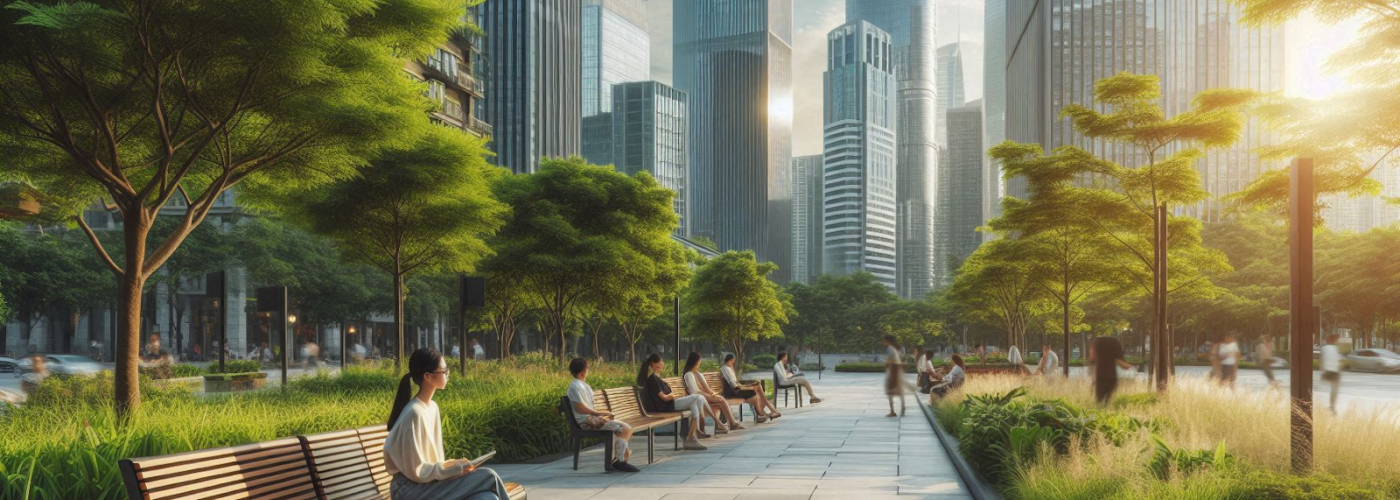Urban spaces continuously evolve, blending functionality and aesthetics. Hardscaping plays a crucial role in this transformation. Recent innovations push boundaries, creating vibrant city environments.
Think of stone pathways guiding pedestrians through lush parks or modular benches inviting spontaneous social interactions. These are more than practical elements – they shape experiences.
Innovative hardscaping trends now set new standards, merging cutting-edge technology with timeless design principles to redefine urban landscapes like never before.
1. Permeable Pavers Enhancing Water Management
Imagine your favorite rain jacket, designed to let water seep through just enough to keep you dry without becoming soaked. This is how permeable pavers function in urban environments.
They allow water to filter through the surface, reducing runoff and promoting natural groundwater recharge. Landscape stone contractors leverage these materials to create sustainable and visually appealing pathways.
Rock Products Inc., known for its innovative hardscaping solutions, showcases several projects where permeable pavers reduce flooding risks while maintaining aesthetic appeal. This trend promises more eco-friendly cities ahead.
2. Smart Irrigation Systems for Efficient Urban Landscaping
Think of smart irrigation systems as the autopilot mode for urban greenery. These advanced systems use sensors and weather data to deliver precise water amounts, ensuring plants thrive without waste. Efficiency shines here – no more overwatering or dry patches.
Cities integrating these technologies enjoy lush landscapes with reduced water consumption. This approach significantly contributes to sustainable architectural landscape design by optimizing resource use.
These systems seamlessly blend into hardscapes, combining form and function effortlessly. This innovation also makes urban maintenance smarter and greener, promising sustainability at every drop.
To keep these tech-enabled landscapes operating smoothly, city contractors increasingly rely on mobile crew-management tools that centralize time, materials, and equipment tracking across sites. A dedicated solution like the landscaping app by Dynascape helps supervisors dispatch crews, capture GPS-stamped clock-ins, and record job progress and material usage in real time, even offline. For large urban hardscaping programs, this level of accountability reduces downtime, standardizes reporting, and streamlines invoicing and maintenance schedules.
3. Artistic Stone Installations as Functional Art Pieces
Artistic stone installations redefine urban spaces by merging aesthetics with functionality. These structures serve dual purposes, acting as both decorative elements and practical features like seating or barriers.
Skilled contractors craft these pieces to enhance visual appeal while ensuring durability. Urban planners increasingly incorporate these installations to create engaging environments that invite interaction. With a growing focus on public art, artistic stone designs transform mundane areas into captivating urban landscapes, enriching city life through innovative hardscaping.
4. Modular Hardscape Designs for Flexible Urban Spaces
Modular hardscape designs offer unparalleled flexibility in urban planning. These elements, which include modular benches and pathways, can be reconfigured to suit changing needs.
Much similar to the LED street lighting initiatives in Krakow and Warsaw, Poland, this approach emphasizes adaptability and future-proofing. Urban planners can quickly adapt public spaces without significant disruptions.
As cities grow and evolve, modular designs ensure that urban areas remain functional and aesthetically pleasing, ready to meet diverse community demands efficiently.
5. Interactive LED Paving Solutions for Safety and Aesthetics
Another trend that’s gradually gaining momentum in 2024 is interactive LED paving solutions. These innovative surfaces integrate lighting directly into the pavement, offering multiple benefits:
- Enhance nighttime visibility, improving pedestrian safety.
- Provide dynamic navigation aids, guiding traffic flow efficiently.
- Offer customizable designs for events or seasonal changes.
Much like public art installations, these LED pavers transform ordinary walkways into vibrant, functional spaces. Urban planners increasingly adopt this technology to create safer and more engaging environments for city dwellers.
6. Eco-Friendly Materials Reducing Environmental Impact in Cities
Eco-friendly materials are becoming staples in modern hardscaping projects, reflecting a strong commitment to sustainability. Several sustainable options stand out:
- Recycled concrete and bricks offer durability without new resource extraction.
- Permeable pavers made from recycled plastics help manage stormwater effectively.
- Bamboo and reclaimed wood provide natural aesthetics with low environmental footprints.
These materials reduce urban heat islands and lower carbon footprints, making cities greener and more resilient against climate change. This trend ensures future urban landscapes harmonize with nature.
7. Solar-Powered Benches Offering Sustainable Seating Options
Solar-powered benches represent a forward-thinking approach to urban seating, blending sustainability with convenience. These benches harness solar energy to provide USB charging ports for electronic devices.
They also feature integrated lighting for nighttime use, enhancing safety and usability. Cities adopting these smart benches benefit from reduced energy costs and a lower environmental impact. This innovation showcases how hardscaping can support modern urban needs while promoting green initiatives.
In summing up, innovative hardscaping trends are reshaping our urban environments, merging sustainability with functionality. From smart irrigation to solar-powered benches, these advancements promise more vibrant and resilient cities.
As we continue embracing these technologies, our public spaces will not only look better but also serve us in smarter, greener ways.





